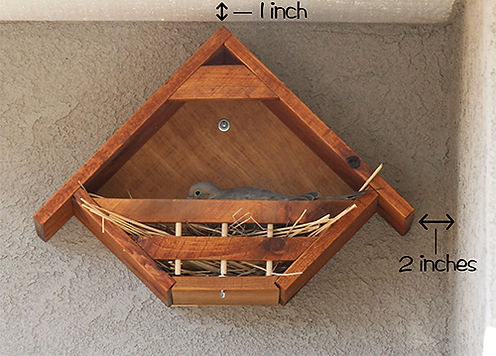Nesting
After experimenting with our dove houses for many years, we’ve noticed that doves have specific needs for where they nest. Below are some helpful tips to attract doves to your dove house.
Mounting Location
-
It’s best to put your dove house on the inside corner of an eave, whether it’s an eave on a house, apartment, garage, shed, carport, or trellis shouldn’t matter. Doves prefer a narrow angle of view wherever they nest. It helps them feel more sheltered. With less wind and weather in the corner of an eave, they feel more protected.
-
For those worried about birds leaving a mess on the side of your house, have no fear! Correct placement of the dove house will ensure that birds won’t have the opportunity to leave unsightly messes on it. Make sure the top corner of the dove house is no more than 1 inch from the eave of your house. This will keep smaller birds from roosting on the top of the dove house. Also, if you mount the dove house on an inside corner of your house, leave at least 2 inches of space between the side of the dove house and the inside corner of your house. This will ensure that other birds do not roost on the side corners of the dove house.

-
Having a shrub, tree, or large plant of some kind nearby can be helpful in attracting doves to a certain location.
For the Doves’ Benefit
-
When first mounting the dove house, it can help to put some straw in the house as nesting material. Doves aren’t great at building nests. They’re more likely to nest in your dove house if everything is already setup and good to go.
-
If you clean the dove house the day after the young leave the nest, often the parents will return within 4 to 5 days to nest again.
-
Try not to disturb the nesting area during the 4 to 5 days that the parent doves are absent other than to clean the nest out and add fresh straw.
-
Doves like to nest near a landing pad of some kind (fence, gutter, wood post, tree, shed).
-
Doves prefer to have a direct flight path from the nest to an easy landing spot 10-20 yards out. This is for their young, so that when they’re ready to leave the nest, they have a straight path to the ground, where the parents will be awaiting their first flight.
-
You’re unlikely to have doves nest in a dove house that faces a bird feeding station, because, with so many birds gathered in one place, it’s also a feeding station for predators like hawks, falcons, and cats.
-
Young doves sit on the ground for several days after first leaving the nest. If you have a pet cat or you have regular visits from neighborhood cats, we do not recommend you purchase our dove houses. Cats will seek out and kill young doves.
Climate
-
Doves aren’t all that different from people in that they want a comfortable spot to raise their young. Doves enjoy shade and mild temperatures: they prefer not to nest in full sun.
Last Ditch Effort
-
Doves coo when nesting. If the male Dove is cooing near the bird house you have a 50/50 chance of success . If you’ve done all the above with no success, try throwing bird seed on the ground near the dove house site, change the direction the dove house faces, or move the house to a new location.
